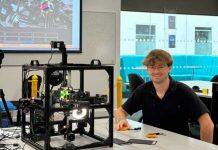

National Geographic defines an ecosystem as a place “where plants, animals, and other organisms, as well as weather and landscapes, work together to form a bubble of life.”
The Alberta government is fostering just such a supportive and productive environment for the province’s burgeoning health technology industry, with more than $15 million in new funding to encourage innovators and entrepreneurs to take their discoveries from concept to products fit for market.
The money will go to 19 technology companies, community organizations and post-secondary institutions over three years, through Alberta Innovates’ new Ecosystem Development Partnerships Program.
“There’s no better time to be in tech in Alberta than now. We know the importance of ensuring appropriate supports are in place to help small and medium-sized technology companies grow and bring their ideas to market,” said Nate Glubish, minister of technology and innovation, in his announcement today at the University of Alberta. “The investments being made in these organizations will help solidify Alberta’s reputation as a growing and thriving technology hub.”
One of the largest grants of $1,853,750 goes to ST Innovations, the business arm of the U of A’s SMART Network, which brings together more than 300 researchers, staff and learners from engineering, medicine, rehabilitation, computer science, neuroscience and the social sciences to develop intelligent augmentative and restorative technologies and health innovations for people with diverse abilities, including those affected by neural and spinal cord injuries.
“We have all the facilities, the skills and the resources to advance Alberta-based digital health technologies, taking innovations from concepts to prototypes and right through to validation to make them market-fit and suitable for additional investment, manufacturing and upscaling,” said Vivian Mushahwar, professor of medicine, physical medicine and rehabilitation division, in the Faculty of Medicine & Dentistry and director of both the SMART Network and ST Innovations.
Often university researchers have to look outside the world of academia when they want to develop a discovery into a real-world product that helps patients, but ST Innovations turns that on its ear, inviting inventors to use the expertise and equipment available only at the U of A.
“By working with industry, we aim to translate discoveries and ideas to near-market solutions, in a faster and more impactful way,” Mushahwar said. “This pushes the health technology ecosystem in Alberta to critical capacity so that it can explode on the national and international scene.”
“We have a world-class research ecosystem here at the U of A, with a proven track record of commercializing ideas to help solve real-world problems. This funding will help advance a number of important projects and will reinforce our reputation as an institution that brings academia and industry together. This is great news for the university and for Alberta’s tech sector,” said Bill Flanagan, president and vice-chancellor.
Other U of A projects receiving funds from the new program include $650,000 for the 5G Living Lab, a five-year partnership with TELUS, and $1.75 million for the Alberta Collaborative Resources Empowering Advanced Technology Experiences (CREATE) Centre, which brings together the U of A’s nanoFAB, Industry Sandbox for Artificial Intelligence Computing and Elko Engineering Garage to provide open-access resources and support for innovators building big, small and intelligent technologies.
Building on success
Mushahwar’s team will work with Alberta Innovates to identify small and medium-sized companies that will be eligible for up to $75,000 worth of services from ST Innovations. ST Innovations was established in 2019 with a $2.3-million investment from the Government of Alberta and augmented with $1.8 million in additional equipment from Prairies Economic Development Canada, including a laser micro fabrication suite used to rapidly prototype tiny medical device components.
Over four years, more than 40 Alberta companies have used ST Innovations’ services, 15 medical technology prototyping projects with industry partners have been launched, three major multinational health technology companies have reached out to collaborate, 90 highly skilled jobs have been created and 150 highly qualified personnel have been trained, according to Mushahwar.
Kinetisense out of Medicine Hat has developed a markerless motion capture system that allows people who use wheelchairs to get biomechanical diagnoses from anywhere using remote health-care systems. Edmonton’s Health Gauge has created a smartwatch that uses artificial intelligence to provide vital signs. And Bio-Stream, co-founded by a U of A professor, has used ST Innovations’ biological testing centre to develop a biosensor that uses saliva and other bodily fluids to diagnose illness.
Supporting entrepreneurs who have good ideas wherever they live in Alberta is part of the point of the new program, according to Alberta Innovates CEO Laura Kilcrease.
“Alberta Innovates created the Ecosystem Development Pilot Program to address gaps in the innovation continuum from ideation to commercialization, to reach rural and under-represented populations, and to bring additional specialized knowledge into the system to spur entrepreneurial growth and mindset in every part of Alberta,” she said.
Focusing on patients
Mushahwar’s own lab’s projects are focused on improving the abilities of people with neurological conditions and spinal cord injuries, and on preventing some of the secondary complications related to reduced mobility and impaired sensation, such as pressure ulcers and deep vein thrombosis.
One clinical quality device has been validated and scaled up to human size and is currently undergoing testing in animals. A non-invasive approach to improve walking using existing rehabilitation interventions in new ways will soon be translated to a clinical setting. A personal undergarment designed to reduce pressure sores has received FDA approval in the United States and will be manufactured by a third party. And the team has recently patented another technology to improve circulation in the legs of people who are unable to move.
For Mushahwar — whether with her own projects or those taken on by ST Innovations — the goal is to support innovative, homegrown technology solutions that make life better for patients.
“We aim to translate the great research and innovation that we are doing here into commercializable solutions that improve the health of Albertans,” she said. “Alberta could become a hub for digital and health technology innovations for everyone in the nation and beyond.”







































